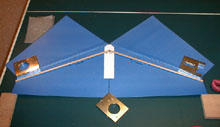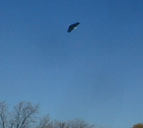
Navigation:
Home
F3 Wing
Overview
Plans & Parts
Construction
Setup & Mods
| F3 Wing -- Overview | |||
Specifications:
|
|
| Here's a fun to fly, inexpensive, easy to build airframe using "folded" foam! | |
Introduction
The F3 Wing (Folded Foamy Flying Wing) is my third flying wing design. I got inspired to create it after a friend told me I could purchase "Depron" style foam sheets (3/32" thick) at our local floor tile store (try asking for Award AUN109 underlayment -- about $5 per 54"x29" sheet). I used a planform similar to the tgworks Chinook glider, but added electric power and used a fairly novel construction technique to form the airfoil.
Design
The F3 Wing is the result of my second experiment using a folded foam airfoil (I had previously built a Pibros delta glider). My goal for this project was to test the feasibility and performance of an inexpensive, powered, folded foam wing. As you can read in the "Flying Characteristics" section below, the experiment turned out quite good, in my humble opinion.
The novelty of this design is that the spar system helps form the airfoil while providing stiffness (see the "Construction Technique" section for pictures). Using this technique also helped keep the weight of the airframe low, since extra foam was not needed to build up the airfoil. I chose to use a tractor configuration for this design to accommodate the positions of the spar system and single vertical stab. It also helped to insure that no additional nose weight would be needed to balance the wing properly. The battery and motor were exposed to allow for good cooling, simple construction, and easy battery changing.
When designing a flying wing aircraft, the pitching moment of the airfoil (Cm) is an important parameter in determining how much washout (twist) is needed at the tips to allow stable flight at low speeds. Based on my experience with flying wing airfoils, I had to estimate the Cm for my folded foil. I then used the Panknin twist formula to generate the proper twist and CG placement. I also tried to keep the roll moment small by confining all the electronics to a small space in the center of the wing.
Construction Technique
Here's a summary of the construction of the F3:
- Cut out the wing bottom, top pieces, and inner support panel from the Depron foam sheet. Tape the top pieces to the bottom pieces at the leading edge.
- Cut out the motor/battery mount from 4mm coroplast and cut 2 spars from 5/16" dowel stock.
- Epoxy the motor/battery mount onto the wing bottom.
- Use 1/2" thick blocks to create the proper twist at the tips and epoxy the spars onto the wing bottom.
- Epoxy the inner support panel onto the spars and wing bottom (near the trailing edge).
- Spray 3M 77 glue onto the inner support and fold both top pieces over. Tape the top pieces to the wing bottom along the trailing edge.
- Cut out the elevons and vertical stab from the Depron foam sheet. Tape on the elevons and glue in the vertical stab.
- Cut holes in the top of the wing for servos, receiver, motor, and battery. Tie wrap the motor to the motor mount and tape in the other components (the ESC fits inside the wing via the battery cut-out).
- Decorate top and bottom with some colored packing tape.
I would estimate that the cost of the parts to make the airframe (not including electronics) to be around $10 -- this is the lowest cost airframe I've designed and built to date. I hope to have more detailed plans on my website by the time this article reaches the web.
Flying Characteristics
The F3 Wing is a fun to fly model with aerobatic capabilities, good low speed handling, and decent top end speed (it's a bit faster than my Zagi). Hand launch, landings, and small field flying are easy due to the low wing loading. Climb rate is good and level flight can be accomplished with about 1/3 to 1/2 throttle, depending on which battery pack is used. Power off glide is also surprisingly good for a relatively small aspect ratio wing. Like most flying wings, stall recovery is quick. It has no tendency to tip stall due to the generous washout built into the wing. It is very quiet -- much quieter than my pusher models. The roll rate is very fast -- an axial roll can be completed in less than 1/2 second. I use a dual rate aileron setup on my transmitter to make roll control easier. Pitch rate is also fairly fast, but not "twitchy".
I've had great fun combining loops and rolls to do split-Ss, Immelmans, and Cuban-8s. It looks very cool in the air, too. Inverted flight is also pretty easy -- some forward stick is necessary to keep the model level while inverted. The performance with the 1400AE pack is noticably more spirited -- the extra mass and power it provides allow for higher speeds and larger vertical manouvers. There's enough power to perform a fairly good size loop while adding a roll at the top. My flight times have averaged around 5 minutes using the 600AE packs and about 12 minutes with the 1400AE packs.
Conclusion
The highlights of this design are:
- fun to fly (can fly in small fields)
- low cost airframe (about $10 not including electronics)
- simple and quick to build (no hot wire cutter needed; about 4-6 hours to build)
- dual purpose spar system (forms airfoil and provides stiffness)
- quiet operation (due to tractor configuration)
Designing, building, and flying the F3 Wing has been a fun, rewarding experience for me -- I am consistently surprised by how well the folded airfoil works!




